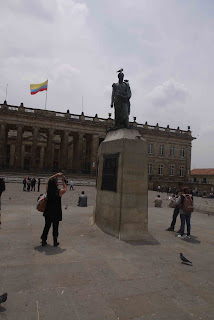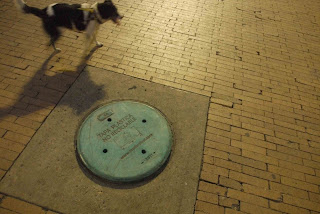 |
| Homeless men pick thru garbage outside the Las Nieves fruit market. |
Too much trash, and too much traffic. We've all seen the huge piles of garbage on corners, which may have decreased, by haven't disappeared now that the city has supposedly got a new company collecting its waste.
And, just a few days ago, Bogotá's traffic congestion was ranked the second worst in all of South America.
 |
| A huge -and routine - traffic jam on Calle 26 in central Bogotá. Wluld a congestion charge help? |
Unfortunately, increasing supply of something only generates more production, leaving the problem as bad or worse.
In the case of Bogotá's garbage, residents who toss trash onto corners and sidewalks have no limit to what they dispose of and no incentive to reduce the waste they produce.
The city's perpetual entreaties to recycle have accomplished little. And recycling is a poor solution compared to not producing the garbage in the first place.
 |
| Carrying plastic bottles - which will be used once and discarded - to a store. Would a deposit keep them out of the landfill? Would it discourage their use in the first place? |
 |
| Bags of organic waste. How about paying flower growers to buy them and turn them into compost? That would save space in the landfill while also reducing greenhouse gas pollution. |
 |
| Tires discarded behind the Central Cemetery. In many places, a deposit paid when a tire is purchased pays for its later reprocessing into something else. |
 |
| A garbage truck painted with a slogan urging people to place recyclables into white bags. |
An obvious one is a deposit on tires, bottles and other disposable items, which would be used to pay
consumers to return those objects to be reused or recycled, and finance their reprocessing into something useful. The beauty of a deposit is that it also shifts the costs to the products' users instead of society in general.
Recycling sounds idealistic, but is much less environmentally sound than simply not generating waste in the first place. And, most of Bogotá's recycling programs are disfunctional, anyway. Take a peek into most recycling bins, and you'll see regular trash in all of them. And the trash collectors have only one place to dump the contents, anyway. The city urges residents separate recyclables from regular trash and place them in white bags. Nobody does this - and for good reason, since the trash collectors have no separate place to carry recyclables, anyway. And even if people did separate out their recyclables, dogs and homeless people would come by and rip open the bags and scatter the trash, anyway.
And the best way to reduce traffic congestion is to raise driving's cost, by hiking the cost of gasoline or introducing a London-style congestion charge for driving into the center of the city. Bogotá's Pico y Placa law, which prohibits cars from driving three days per week depending on their license plate numbers, has obviously failed to reduce traffic jams, and may even be making them worse.
By Mike Ceaser, of Bogotá Bike Tours





















































